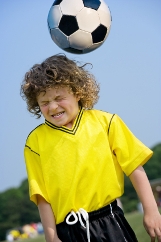Soccer heading in youth
So what, then, about soccer heading in youth? Not surprisingly, no consensus has emerged in this arena, either in terms of whether the science supports the view that the cumulative effects of heading has adverse neuropsychological consequences or as to when it is safe for children to begin heading.
On the science, a 2010 study by the American Academy of Pediatrics' Council on Sports Medicine and Fitness Executive Committe[21] suggested, perhaps prematurely in light of the Lipton study, that the "contribution of purposeful 'heading' of the soccer ball to both acute and potential long-term concussive effects, such as cognitive dysfunction, seems less controversial today, as previously." At the time, it concluded that a critical review of the literature "does not support the contention that purposeful heading contacts are likely to lead to either acute or cumulative brain damage, and additional study is necessary to provide confirmatory evidence of neuropsychological consequences of subconcussive soccer-related head contacts."

A 2012 study [22] by researchers at the Cleveland Clinic concurred, concluding, after reviewing theoretical concerns, the results of biomechanical laboratory experiments, and then-available clinical data regarding the effects of chronic, subconcussive head injury from soccer heading, that there was "no support" in recent studies for the findings of the early Norwegian studies, asserting that more recent studies failed to show that soccer players experience neurocognitive impairment compared with athletes in other sports, or that more frequent headers scored more poorly on sophisticated neuropsychiatric evaluation than less frequent headers.
This is exactly what the Lipton study did find, although, to be fair, the Cleveland Clinic researchers were quick to caution that damage building up over the long term could not be ruled out. The authors thus urged "players, parents, and coaches [to] be aware that although laboratory studies indicate that ... any possible detrimental effect from repetitive subconcussive heading may only become clinically evident decades into the future."
As is so often the case in head injury research, pediatric studies on the effect of cumulative soccer heading on the brains of children are few and far between, with only a handful of studies providing data on heading in youth soccer. [24-26] Similar to the studies on adults, the outcomes are contradictory. [2] The issue, however, as Webbe notes, is "not trivial," citing a 2009 study of which he was a co-author [25] which found that almost 50% of a sample reported concussion-like symptoms (headache, dizziness, balance problems) after heading a soccer ball, similar to post-concussion reports from adolescent and Olympic soccer athletes. [27]
Webbe suggests that, as in adult soccer, politics regarding heading leads some coaches and parents to be reluctant to participate in a study because it might "deter children from heading behavior and competitiveness in the sport."
To delay or not to delay: that is the question
As Florida Tech's Webbe notes in his 2010 book, [2] "Generally speaking, there is general consensus that proper heading technique requires strong neck muscles to form a stable platform bridging the body and head."
A just-published 2013 study [28] found that balanced neck strength may reduce the acceleration of the head during the act of heading a soccer ball, thus reducing the risk of brain injury from such low-grade, subconcussive hits. "Achieving and maintaining a balance in neck strength may be a key preventative technique in limiting acceleration, hence limiting the potential risks of repetitive heading in soccer," writes lead author Zachary D.W. Dezman, M.D., a resident in the University of Maryland School of Medicine Department of Emergency Medicine.








